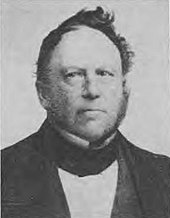Hunte-Ems Canal
The Hunte-Ems Canal was an artificial waterway in northern Germany .
history
Already in the 18th century there were considerations for the construction of a canal through the Oldenburg moors, which should connect the Ems with the Hunte . The background was the interest of the Grand Duchy of Oldenburg in connecting the Lower Weser ports, which were then part of Oldenburg, with the Ems.
Planning and routing
The plans became more concrete when Oldenburg, as a brief part of the French Empire, was affected by the English continental blockade. To bypass this blockade, a shipping link between the Baltic and the Rhine should be established outside the English zone of influence. From 1810, for example, French and Dutch engineers pushed ahead with more specific planning and surveying work on the canal route . It was also recognized that, in addition to cargo shipping, the drainage and cultivation of the moorland between Hunte and Ems, a high profitability of the project called " Hunte-Ems Canal " at that time could be expected.
After the fall of Napoleon in 1813, about 30 years passed before the canal construction was actively promoted again through the initiative of Georg Amtmann and his brother-in-law Johann Ludwig Mosle . As a bailiff, Amann had previous experience in hydraulic engineering and in 1826 published an anonymous proposal for a “ Hunte-Ems Canal ” in the “Oldenburgische Blätter”. In 1844 the Oldenburg Shipping Commission in Brake , to which Amann belonged, took up the proposal and proposed in two reports to the Oldenburg government the construction of the canal to create a traffic route on the one hand and for drainage and thus the development and colonization of the Oldenburg bogs on the other. However, the government again rejected these proposals. The combination of the improvement of the infrastructure with the advantages of the solution for the agrarian Oldenburg was the decisive factor for the realization of the plan. In November 1844, Johann Ludwig Mosle gave a widely acclaimed lecture in the Oldenburg Trade and Commerce Association on the construction of the canal based on Amann's work. This brought the breakthrough and the trade and commerce association had the technical preliminary investigations and route planning carried out.
In 1846 the Westersted “surveying conductor” (= technician) Ino Hayen Fimmen was commissioned to present a route for a canal. The plan presented in the same year envisaged a route for the canal from Oldenburg in a westerly direction to Kampe and then in a north-westerly direction to Barßel to the Sagter Ems (former state border Oldenburg / Prussia). From here there was a connection to the Ems via the Leda . This route had a length of 44.43 km. A bed width of 9 m, a water depth of 1.50 m and a water level of 13.50 m were planned. The gradient between Barßel and Oldenburg required the construction of nine locks. The canal was leveled by 1855 .
construction

On September 22, 1855, the actual construction work began at both ends of the canal in Oldenburg and Barßel. In some places, raised bogs with a thickness of 30 feet (8.85 m) had to be pierced by hand. Only after 20 years did mechanical dismantling using the so-called “ Hodge's peat ship ” facilitate the construction work. Nevertheless, it took until October 1, 1893, until the breakthrough at Kampe connected the two construction sites and the entire length of the canal was built. On the bank there was originally a towpath with which small boats with ropes could be pulled along the bank ("trek barges").
economics
Early on, the north-south section of the Hunte-Ems Canal in particular showed a lack of performance due to its small dimensions and too many locks, which made it suitable for 60-t ships (20 m length × 4.50 m width × 1.20 m Draft) limited. Even in the period after the First World War, it no longer met the requirements of a modern transport route. The destination was larger 600 t motor ships , such as those operated on the Dortmund-Ems Canal and the Mittelland Canal . Only if it were on a par with these large shipping routes would a canal meet the shipping traffic between the Ruhr area and Bremen and the traffic demands resulting from high bog colonization and peat farming use. Therefore, the Oldenburg state government pursued the goal of widening the previous Hunte-Ems Canal and building a new, 29 km long "western route" from the former Oldenburg / Prussian state border via Prussian territory to the Ems, a supraregional traffic route to the Ruhr and Rhine area to develop. This route corresponds to today's coastal canal .
Elisabethfehnkanal
The old, 15 km long north-south branch of the Hunte-Ems Canal was decommissioned for the main through traffic in 1935 and named "Elisabethfehn- in honor of Elisabeth von Sachsen-Altenburg , wife of Grand Duke Peter II of Oldenburg " Channel “ renamed. Today it is the last intact and continuously navigable Fehn Canal in Germany. With four hand-operated wooden locks and six bascule bridges, it still shows the appearance of the old Hunte-Ems Canal today. The association “Bürgerinitiative Rettet den Elisabethfehnkanal” is committed to preserving this cultural monument. The Elisabethfehn Canal is owned by the district of Cloppenburg .
literature
- Otto Brandt : The expansion of the Hunte-Ems Canal. Memorandum of the Northwest German Canal Association . Stalling, Oldenburg i. Size 1898 ( digitized version )
Web links
Individual evidence
- ^ Hans Friedl: Amann, Johann Georg. Hans Friedl u. a. (Ed.): Biographical manual for the history of the state of Oldenburg . Edited on behalf of the Oldenburg landscape. Isensee, Oldenburg 1992, ISBN 3-89442-135-5 , pp. 32-33 ( PDF; 4.6 MB ).
- ^ Association homepage "Rettet den Elisabethfehnkanal eV"
